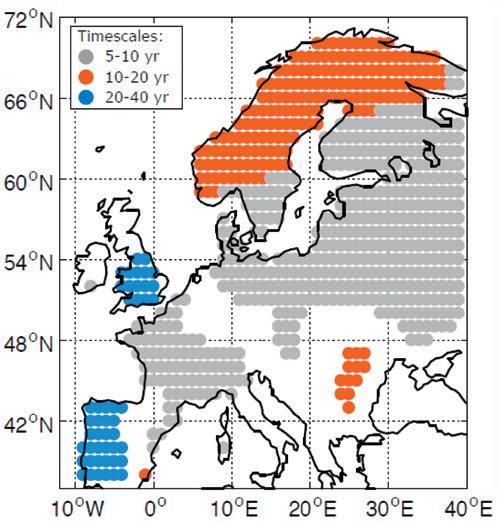
4 minute read
2.2 Multidecadal modes of climate variability in the Atlantic
the corresponding southward currents further east are spread over a wide area with speeds of just a few centimetres per second. As the Gulf Stream travels north, it entrains adjacent waters from lateral and large-scale turbulent eddy mixing, so that transport to the south of Nova Scotia reaches up to 150 Sv. Because this current transports relatively warm water from the subtropics, substantial transfers of heat and energy from the ocean to the atmosphere occur, driving local weather systems and those further afield through atmospheric teleconnections. The northeastward extension of the Gulf Stream, the North Atlantic Drift (or Current), can be tracked from Nova Scotia to Iceland and into the Nordic Seas, interacting with the atmosphere all along. It both separates and is part of the subpolar gyre to the north and the subtropical gyre to the south, the former transporting colder and less saline water from the cool freshwater inputs at higher latitudes (also in Figure 2.1). Although they lose heat and gain freshwater as they cross the Atlantic, the waters of the North Atlantic Drift are still fairly warm and saline when they reach the submarine ridge that extends from Greenland to Scotland via Iceland and the Faroes. A small part of this water crosses the Greenland–Scotland Ridge into the Nordic Seas west of Iceland (Jónsson and Valdimarsson, 2012) while most traverses between Iceland and Scotland (where it is joined by the Slope Current (White and Bowyer, 1997)). Together, some 8 Sv of warm water are estimated to enter the Nordic Seas with a similar amount of cold water leaving (Østerhus et al., 2019). Most of the warm inflow continues northwards as the Norwegian Atlantic Current, which sends branches into the Barents Sea and the Arctic Ocean. On the way, it is cooled by the atmosphere and receives freshwater from river runoff, precipitation and ice melt, as well as outflows of brackish water from the Baltic. As a consequence, approximately 30% of the warm inflow becomes very cold but is still sufficiently fresh that it remains close to the surface, where it combines with water from the Pacific and flows southwards on both sides of Greenland to enter the subpolar gyre. The remaining approximately 70% retains sufficient salinity to reach high densities when cooled, sinks and fills up the deep parts of the Nordic Seas and Arctic Ocean (Mauritzen, 1996; Eldevik and Nilsen, 2013).
These denser waters leave the Nordic Seas through the deep passages across the Greenland–Scotland Ridge, flowing mainly through the Denmark Strait (Jochumsen et al., 2017) and the Faroe Bank Channel (Hansen B. et al., 2016). The total volume transport of these flows (termed overflows) is estimated to be approximately 6 Sv (Østerhus et al., 2019), but shortly after crossing the ridge the overflows entrain adjoining ambient water masses (Fogelqvist et al., 2003), which warms the overflow water and decreases its density, but also increases volume transport by a factor of up to 2 (Dickson and Brown, 1994; Sarafanov et al., 2012; Lozier et al., 2019).
Advertisement
The modified overflow water is supplemented by dense water that has sunk to great depths (termed ‘deep ventilation’) in the Labrador Sea and Irminger Basin. The resulting water mass is the North Atlantic Deep Water, which continues southwards at depth through both the western and the eastern basins of the North Atlantic, constituting the main part of the lower limb of the AMOC.
The AMOC refers to the combination of all these currents, and can be summarised as the net northward transport of waters from the surface down to around 1,000 m depth, compensated for by an equivalent return current at greater depths (plus a net 1 Sv influx across the Bering Strait). As the Gulf Stream and its poleward branches transport warm water of subtropical origin north with colder water masses formed at higher latitudes returning mostly at depth (section 3.1), it provides the northward meridional heat transport that (together with flows of warm maritime air from dominant southwesterlies; Seager et al., 2002) is responsible for the warmer climate in Europe compared with similar latitudes in North America. Whereas the subpolar and subtropical gyres are mainly wind-driven, the dense-water formation is driven by differences in seawater density, caused by temperature and salinity and the associated thermohaline forcing. We discuss potential weakening of the AMOC in a warming world and effects in Europe (Laurian et al., 2010) and beyond (Jackson et al., 2015) in section 2.4.
There may sometimes by an association between the AMOC and the Gulf Stream in the media that is oversimplified. It can thus be useful to keep in mind that the AMOC and its thermohaline circulation overturn from surface-to-deep flow have a maximum strength of about 20 Sv. In contrast, the wind-driven near-surface flows of the Gulf Stream are much greater and peak at more than 100 Sv. Accordingly, substantial return flows are also near the surface. The timing and changes between the two, although related, are accordingly not identical, nor is the degree of correlation constant in time (Johnson et al., 2019).
2.2 Multidecadal modes of climate variability in the Atlantic
When linear trends due to climate warming are removed using statistical filters from historical patterns of SST in the North Atlantic, a multidecadal variability emerges (Figure 2.2). This AMV features in climate models where its cycle ranges from 50 to 100 years depending on the model used. Model results are consistent with the instrumental data in Figure 2.2, but records are too short to allow an exact timescale to be inferred. AMV





